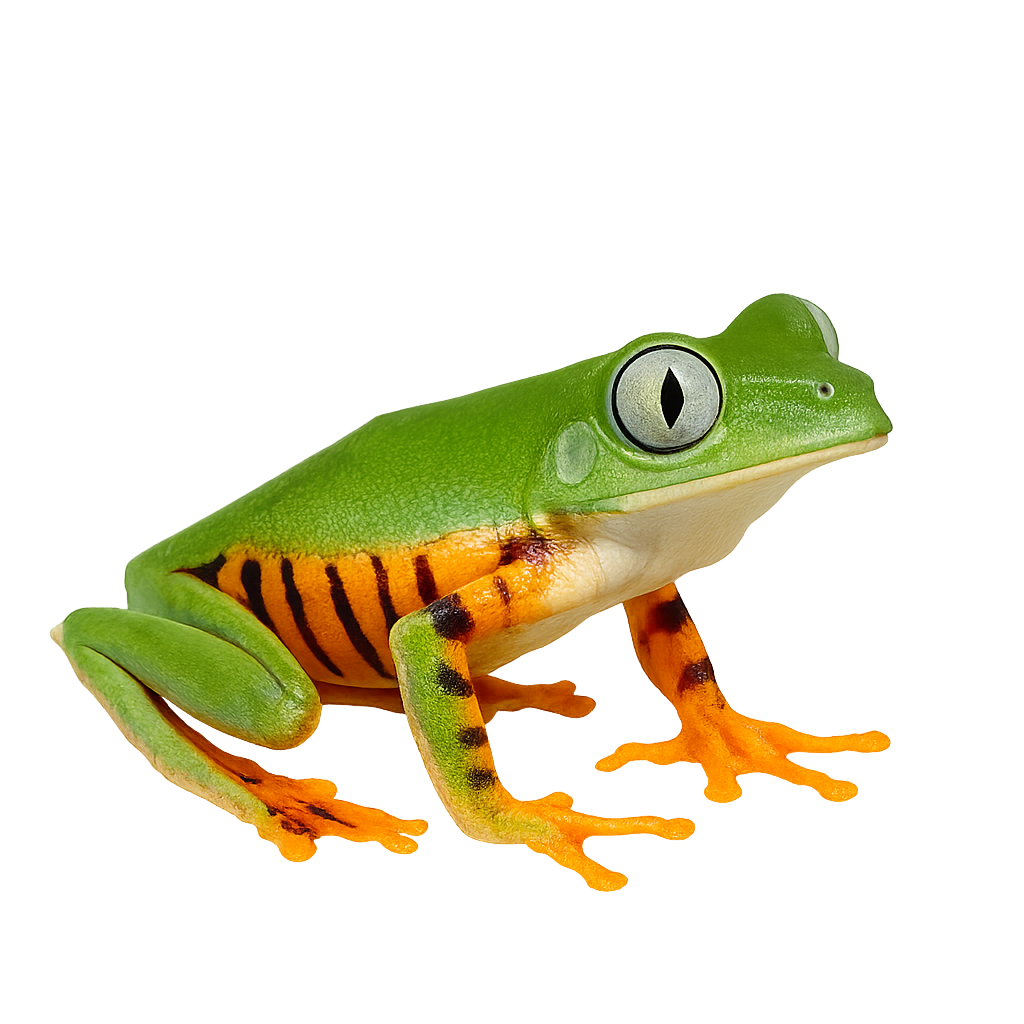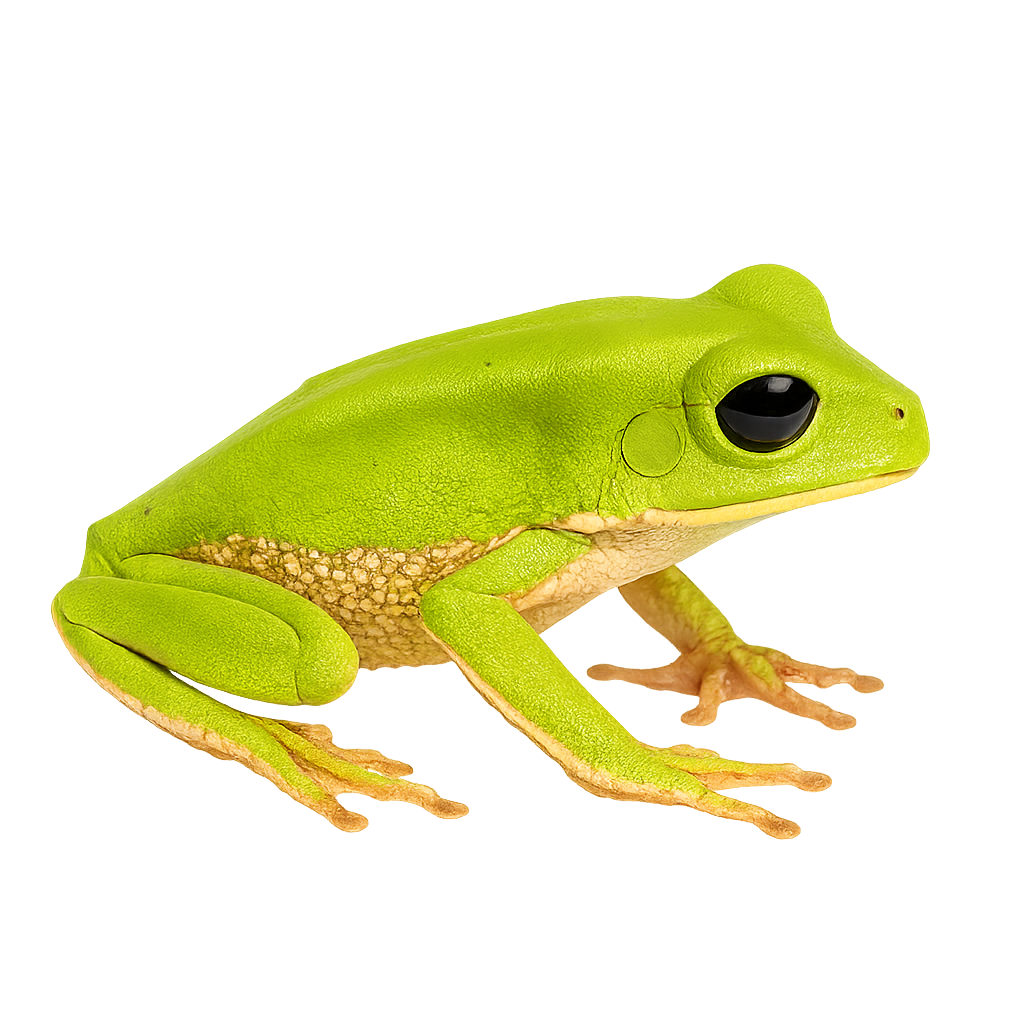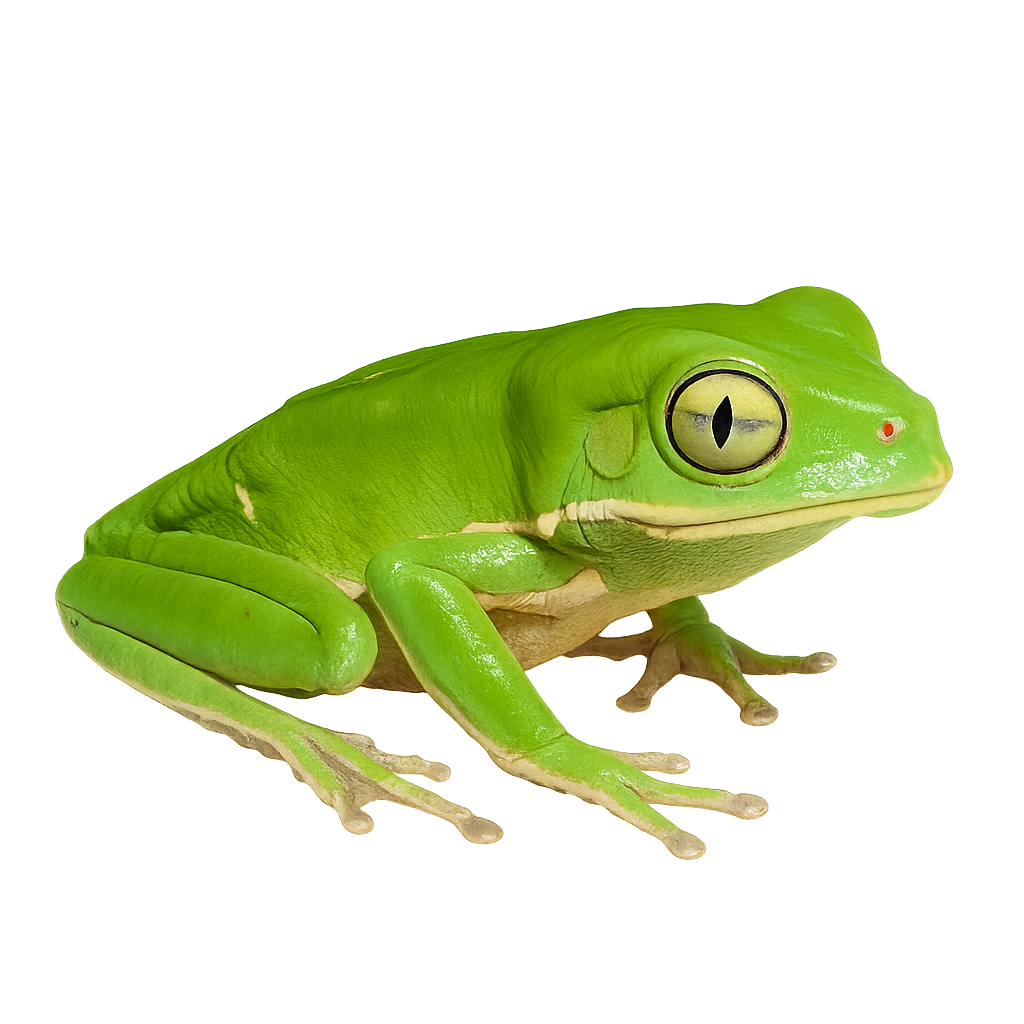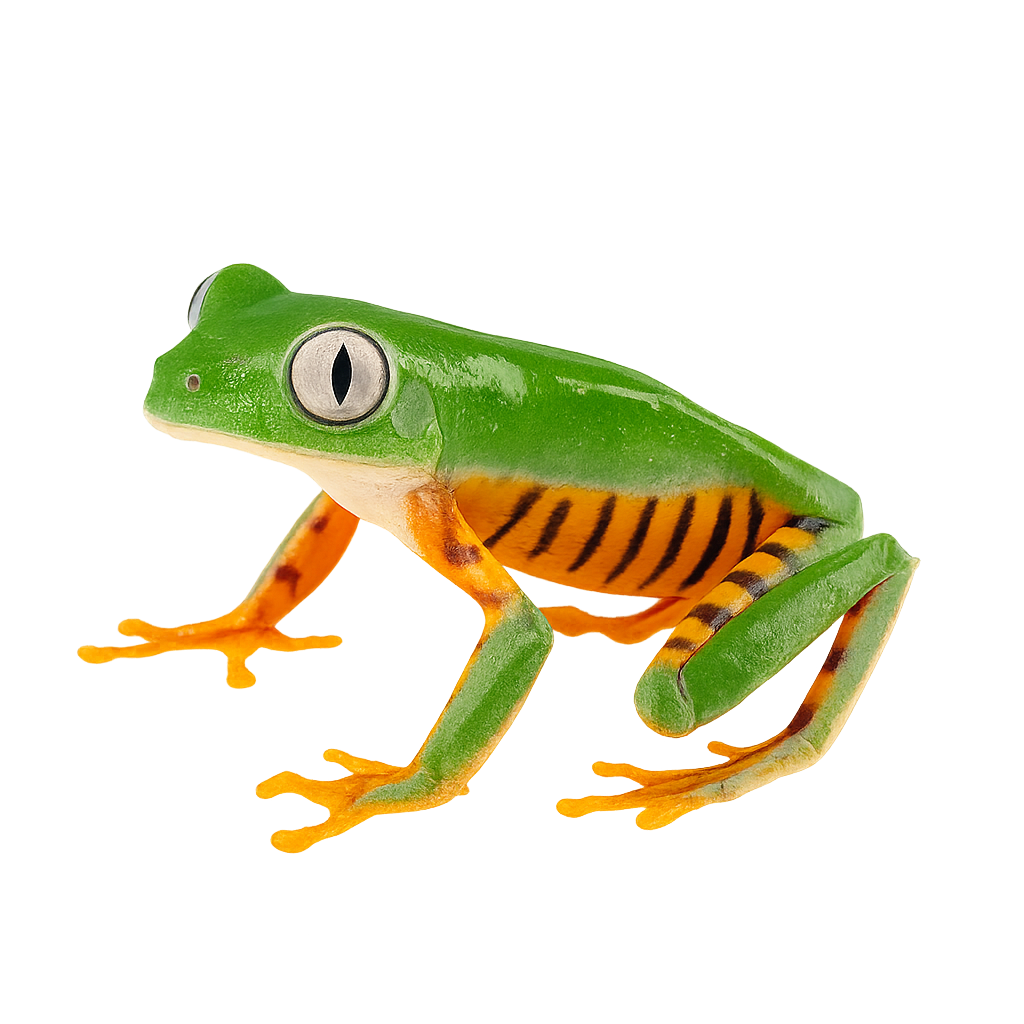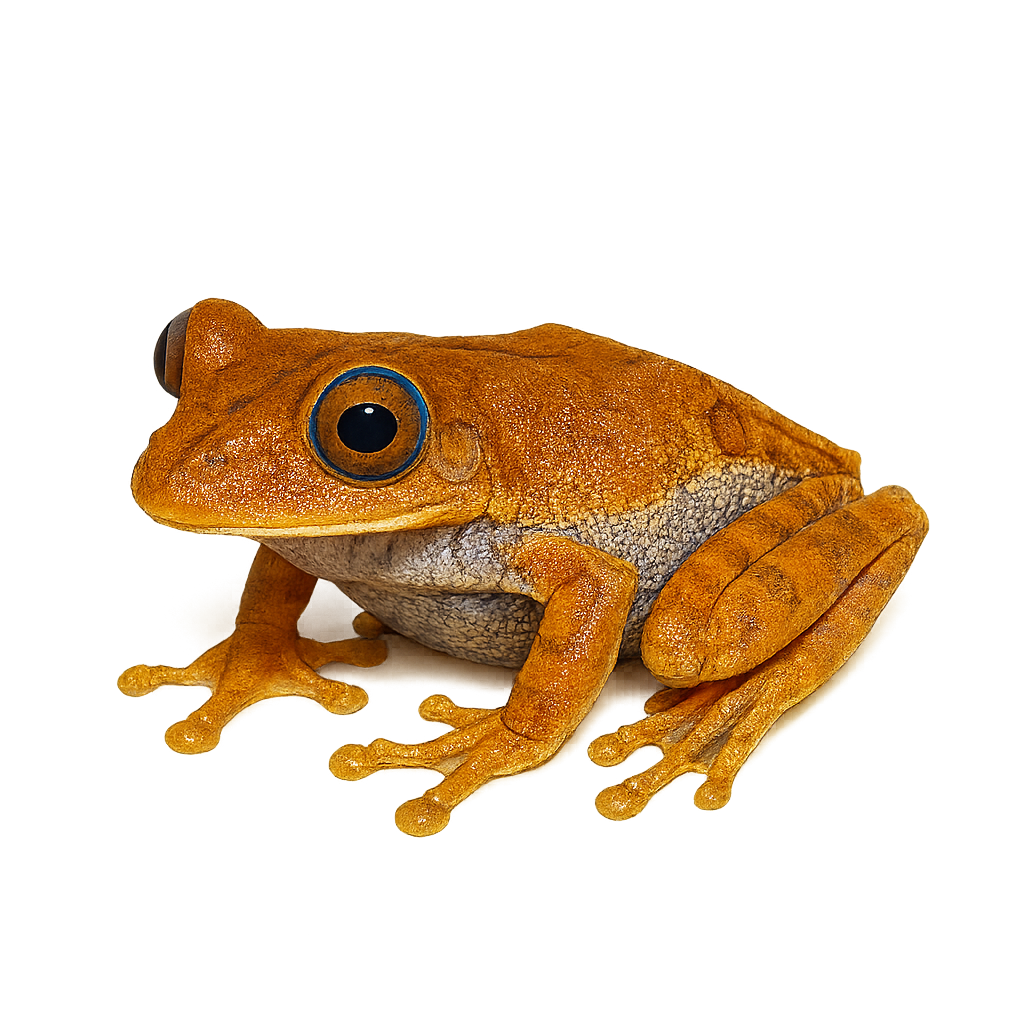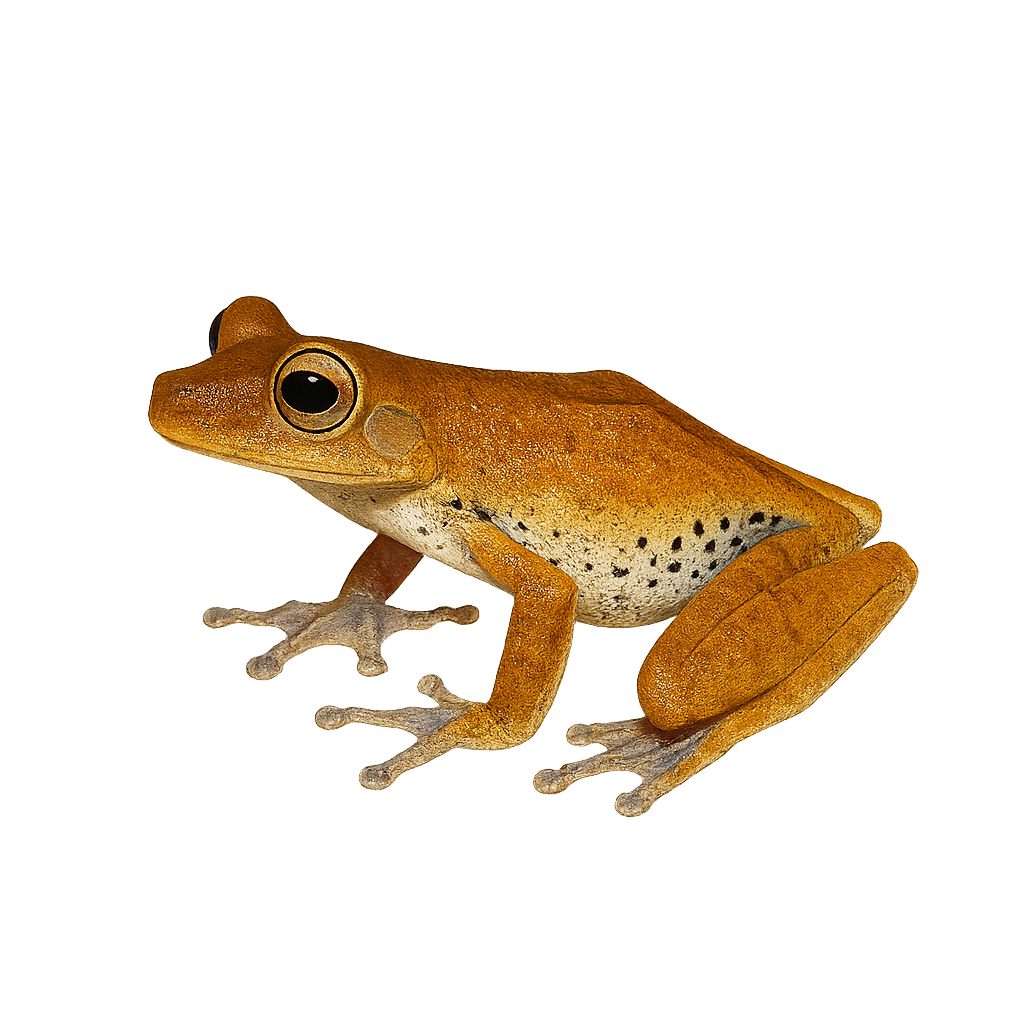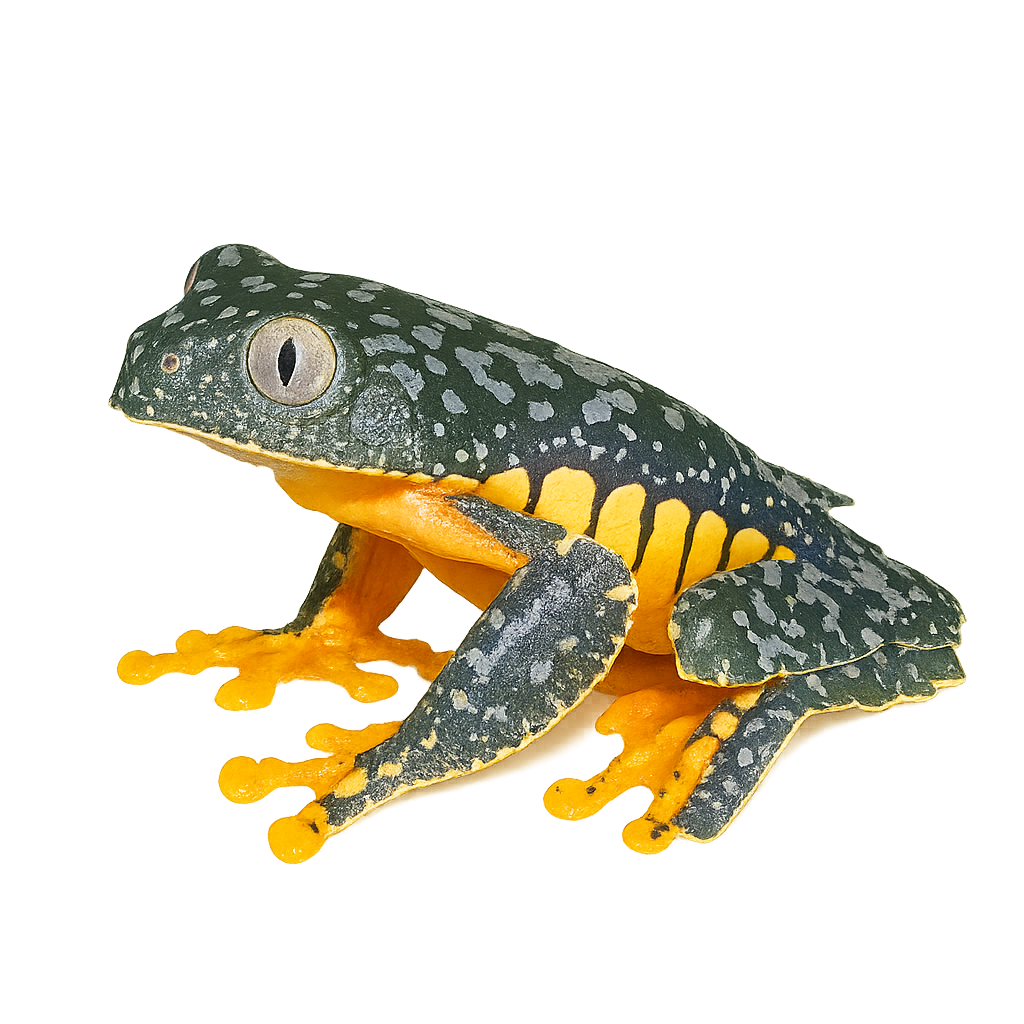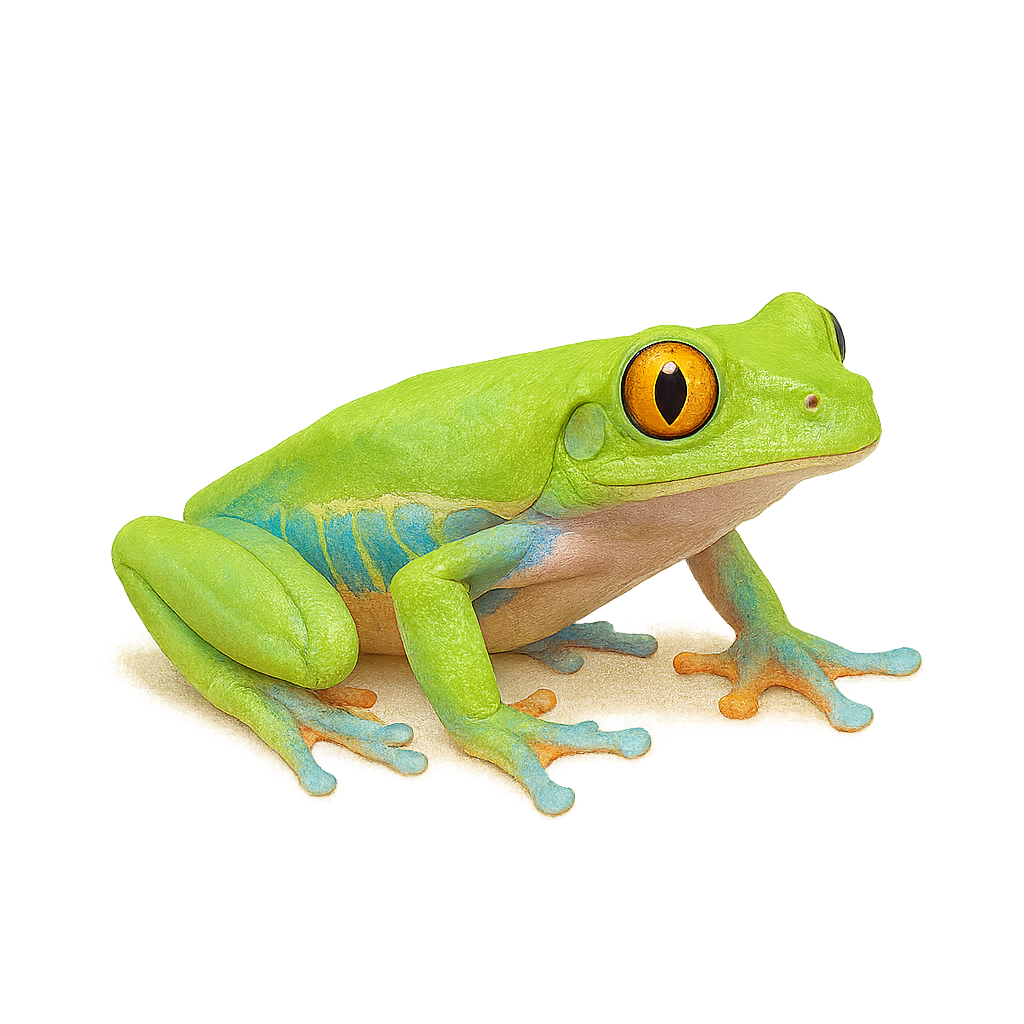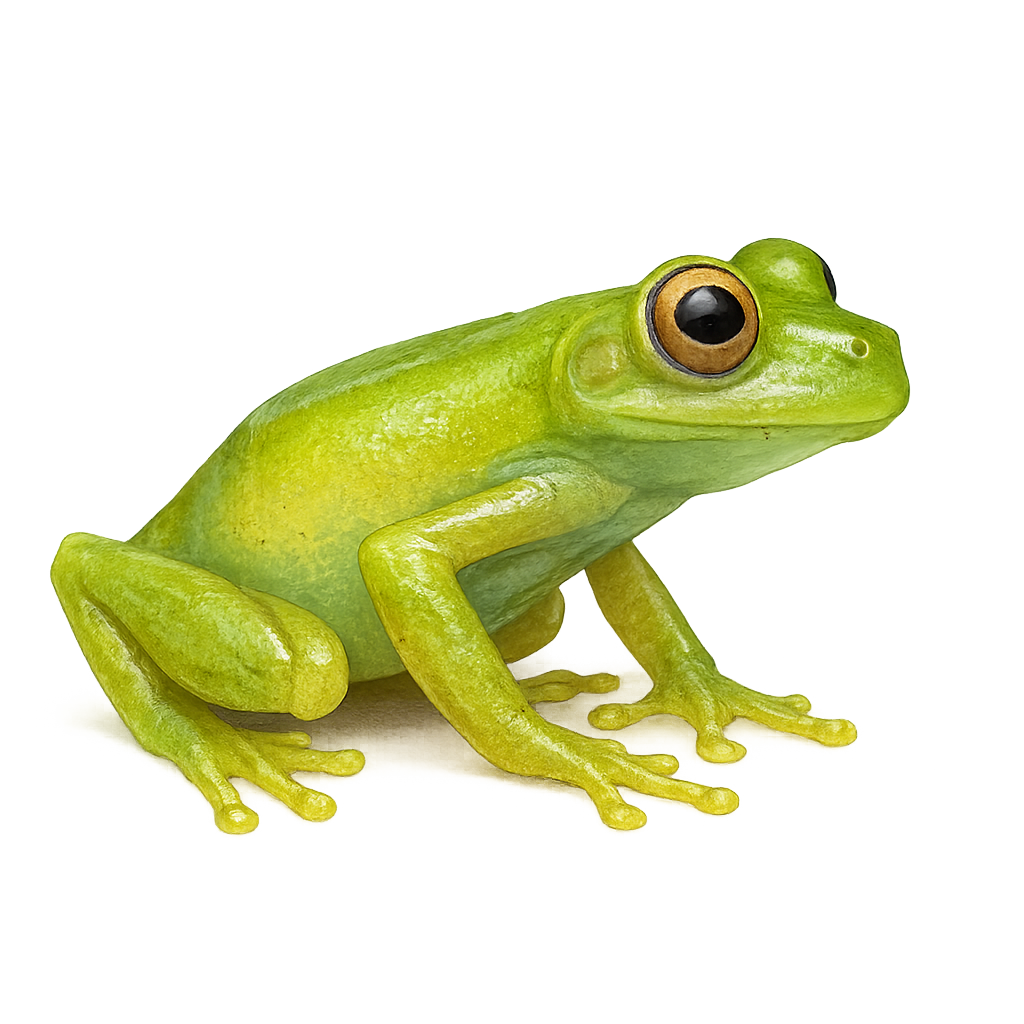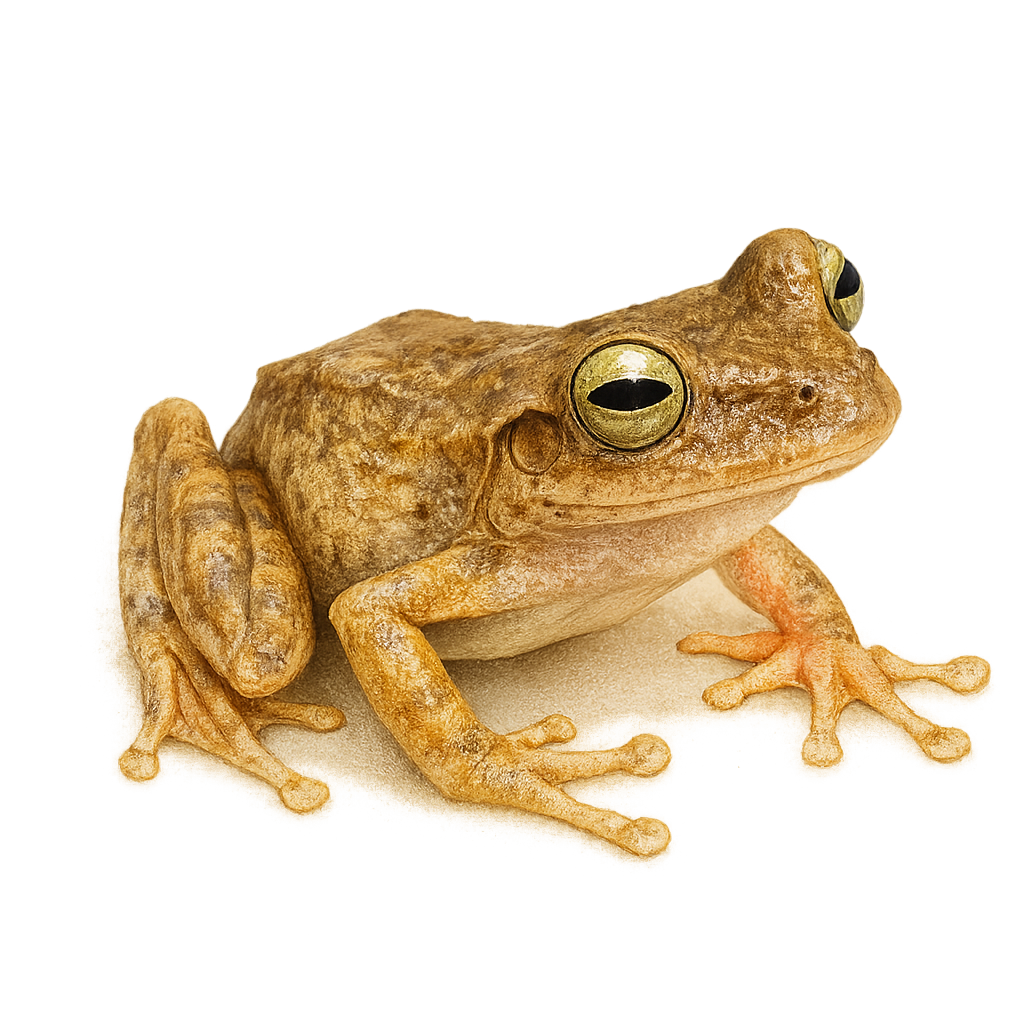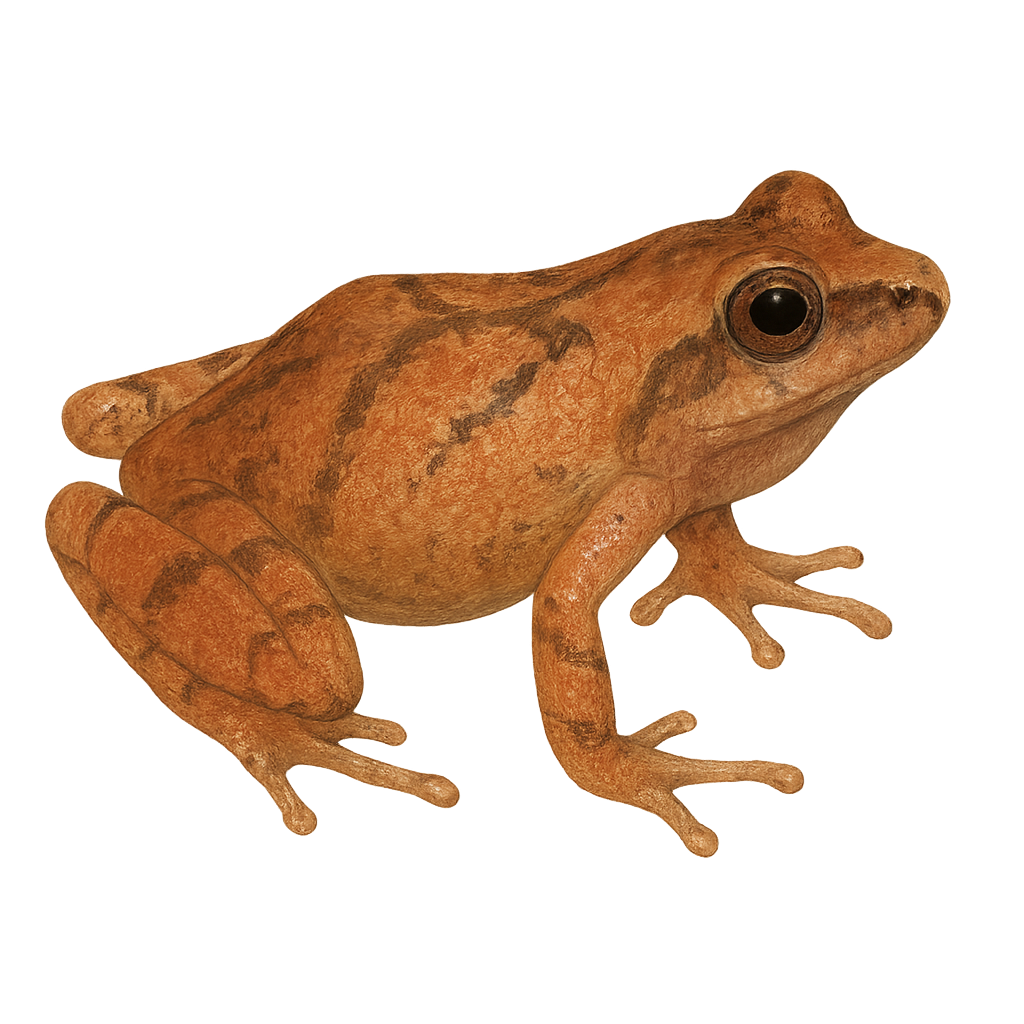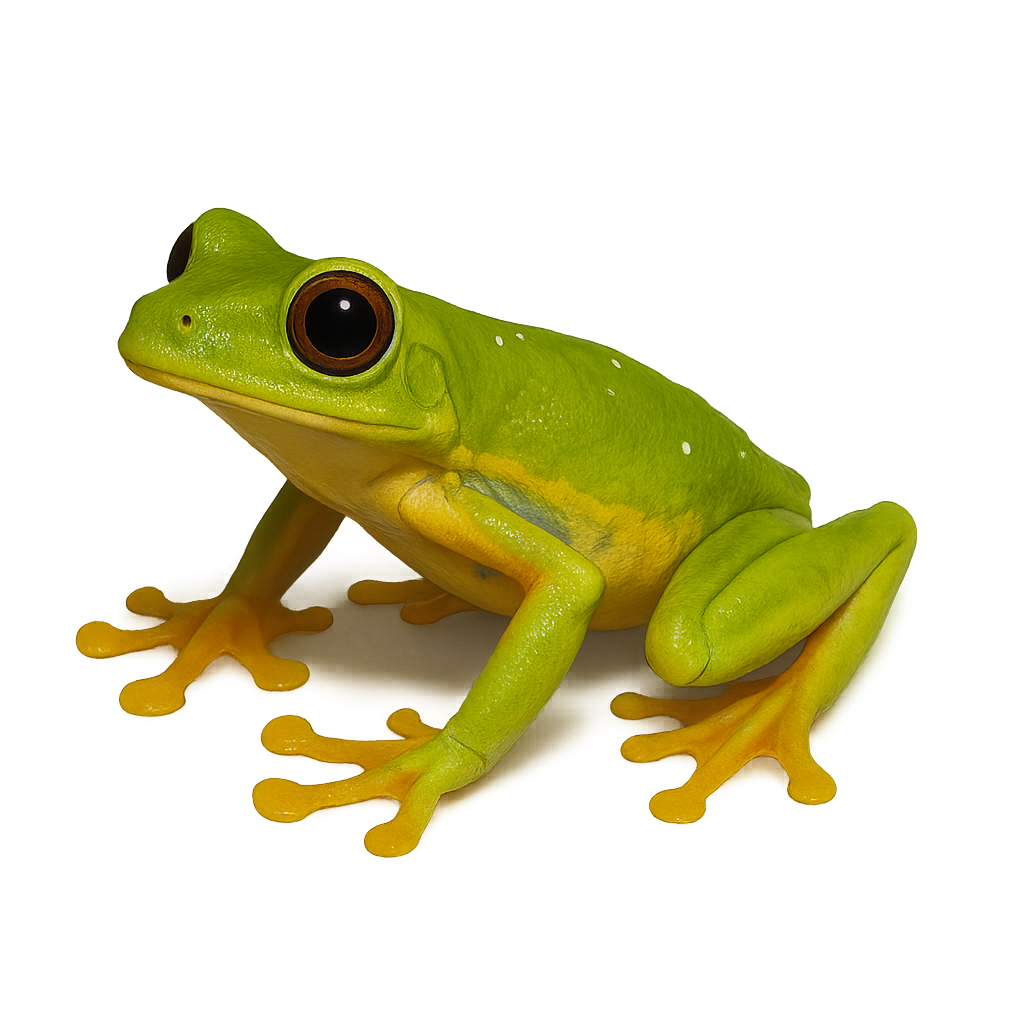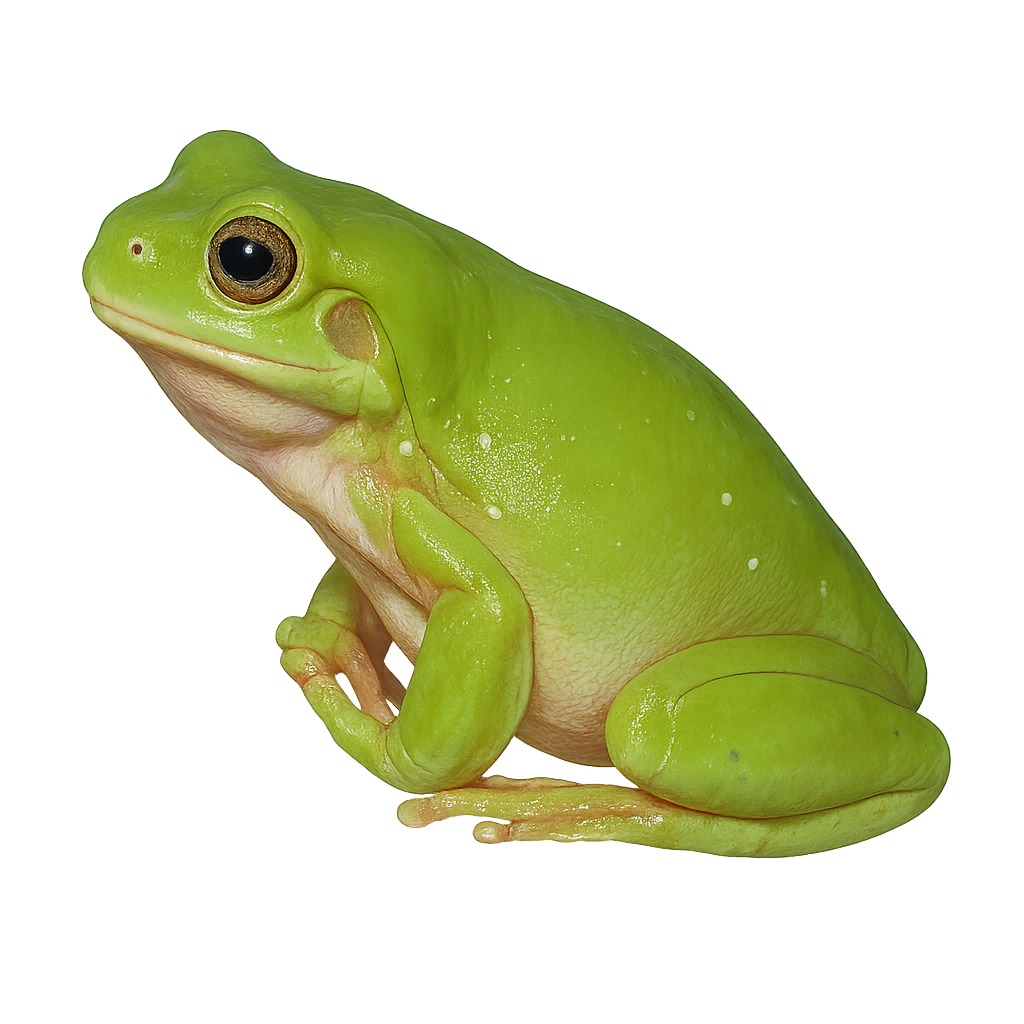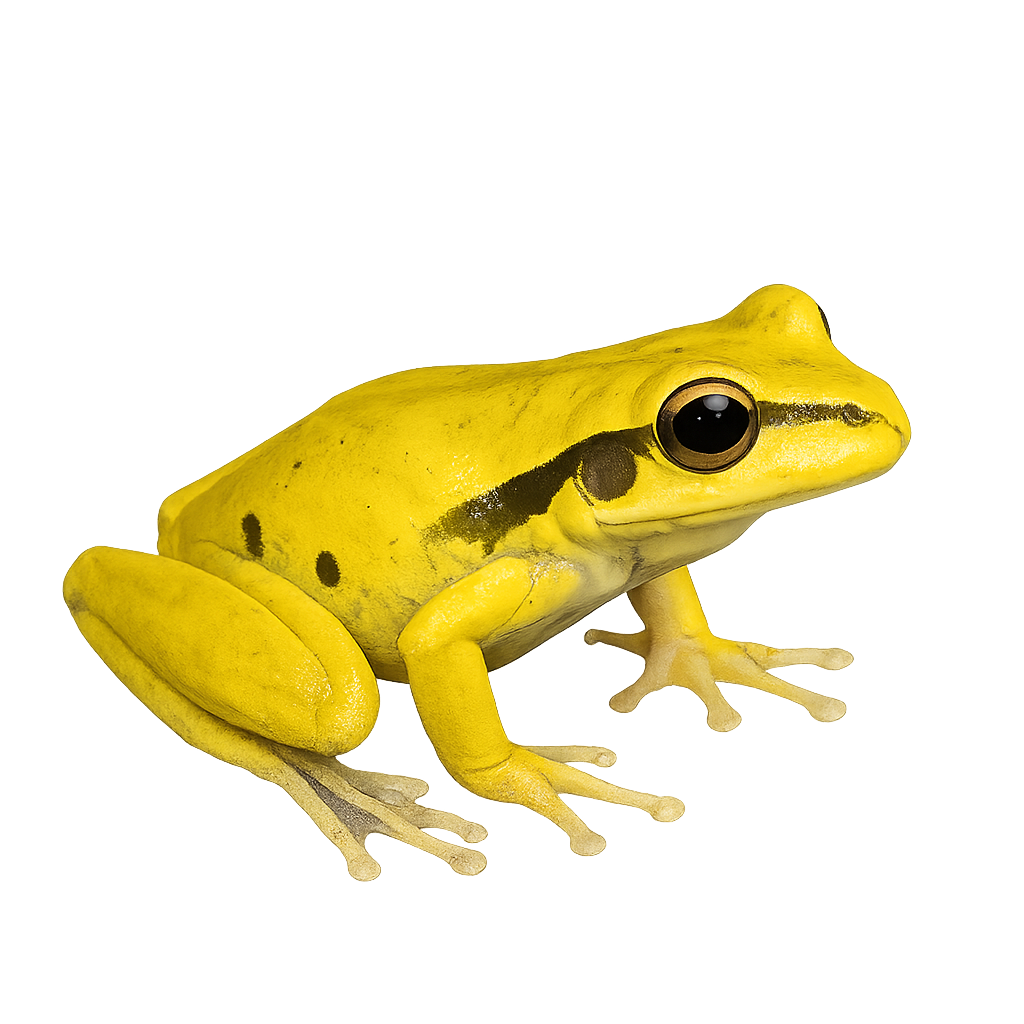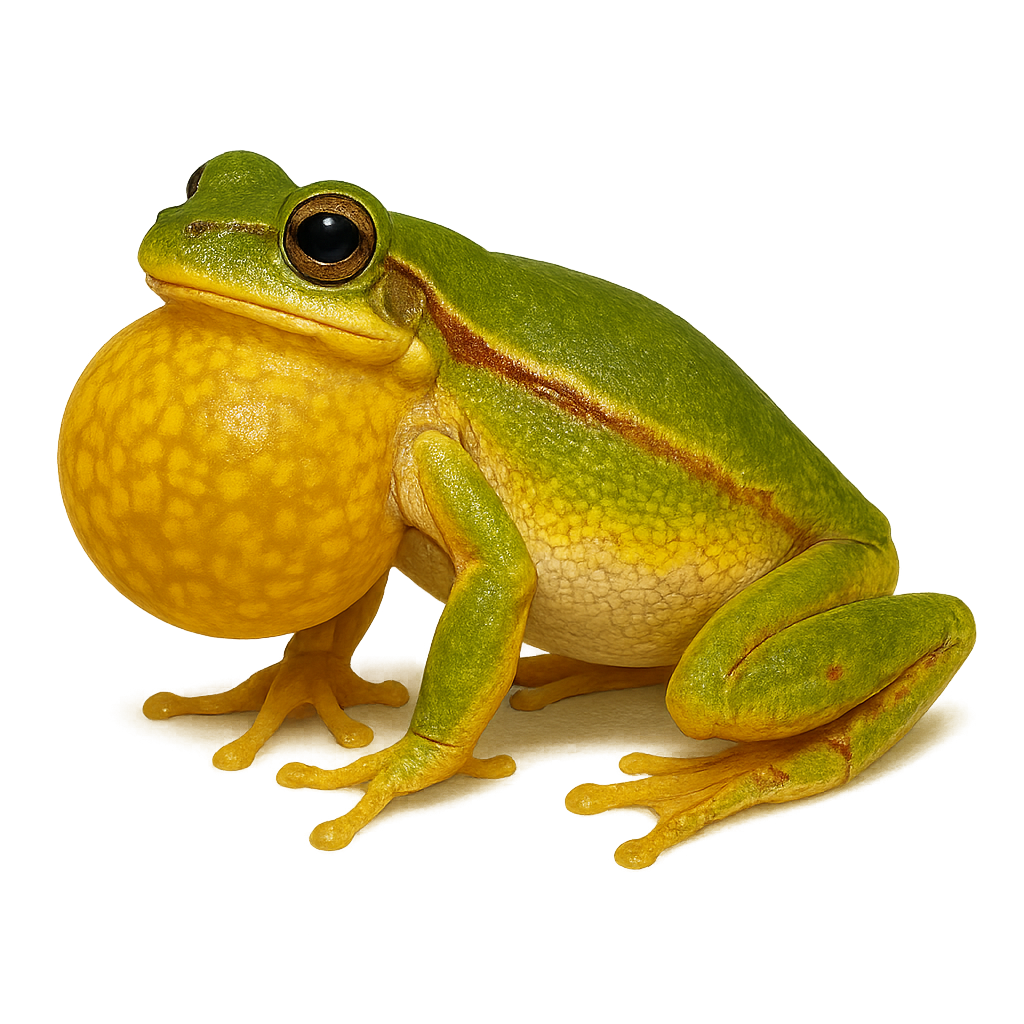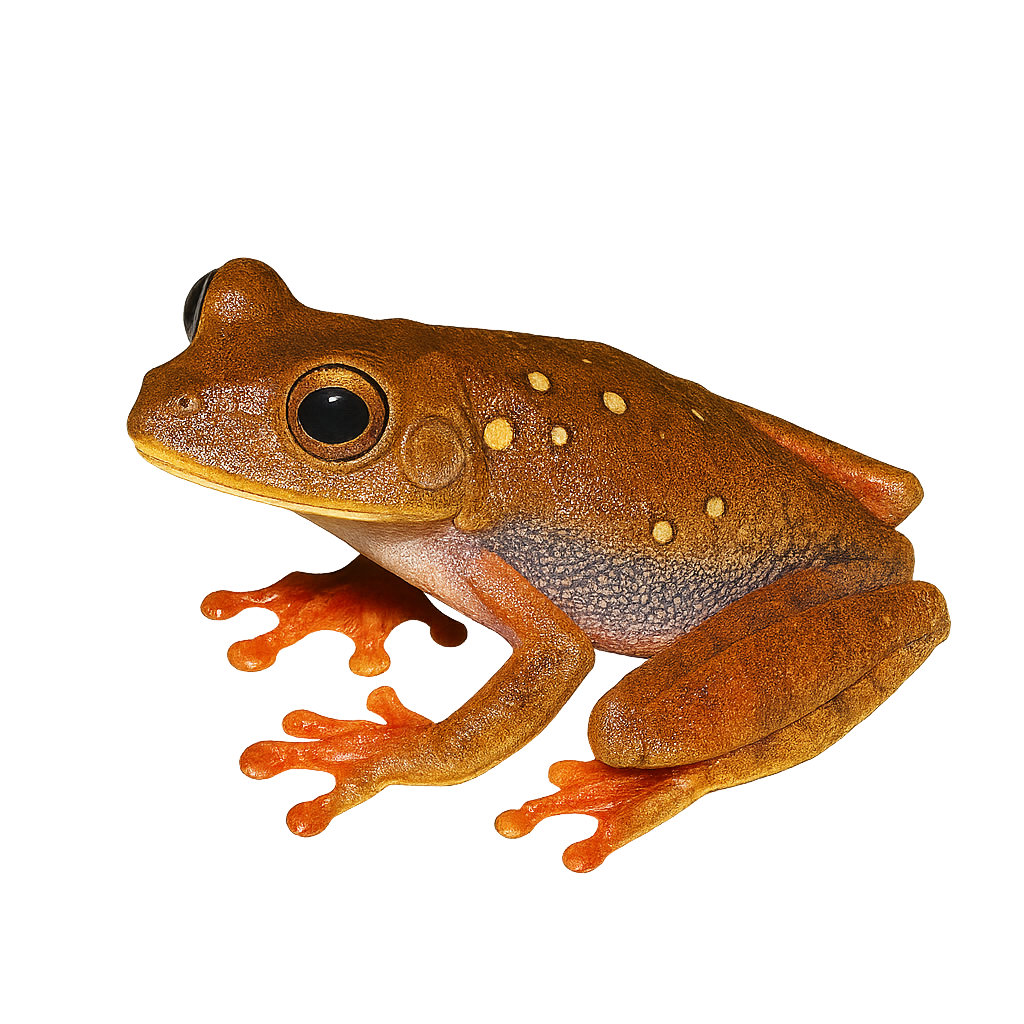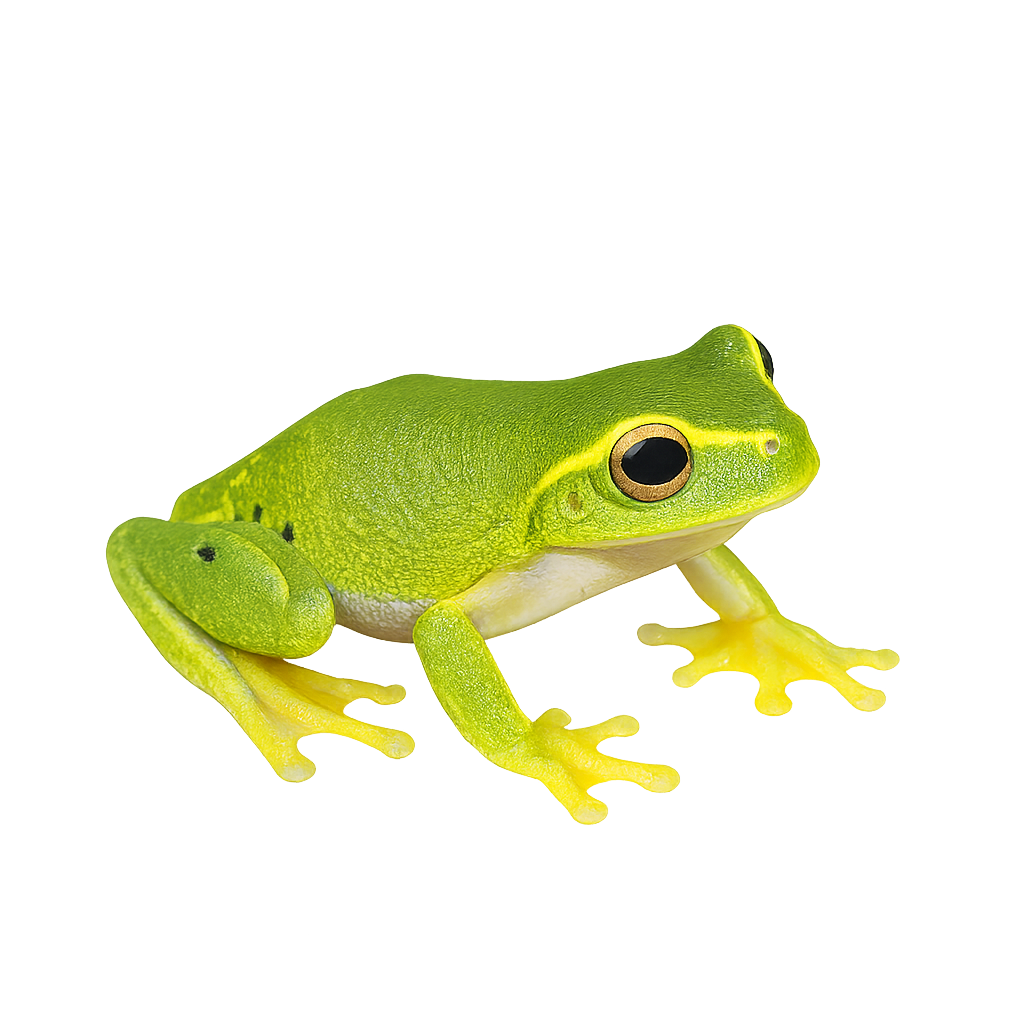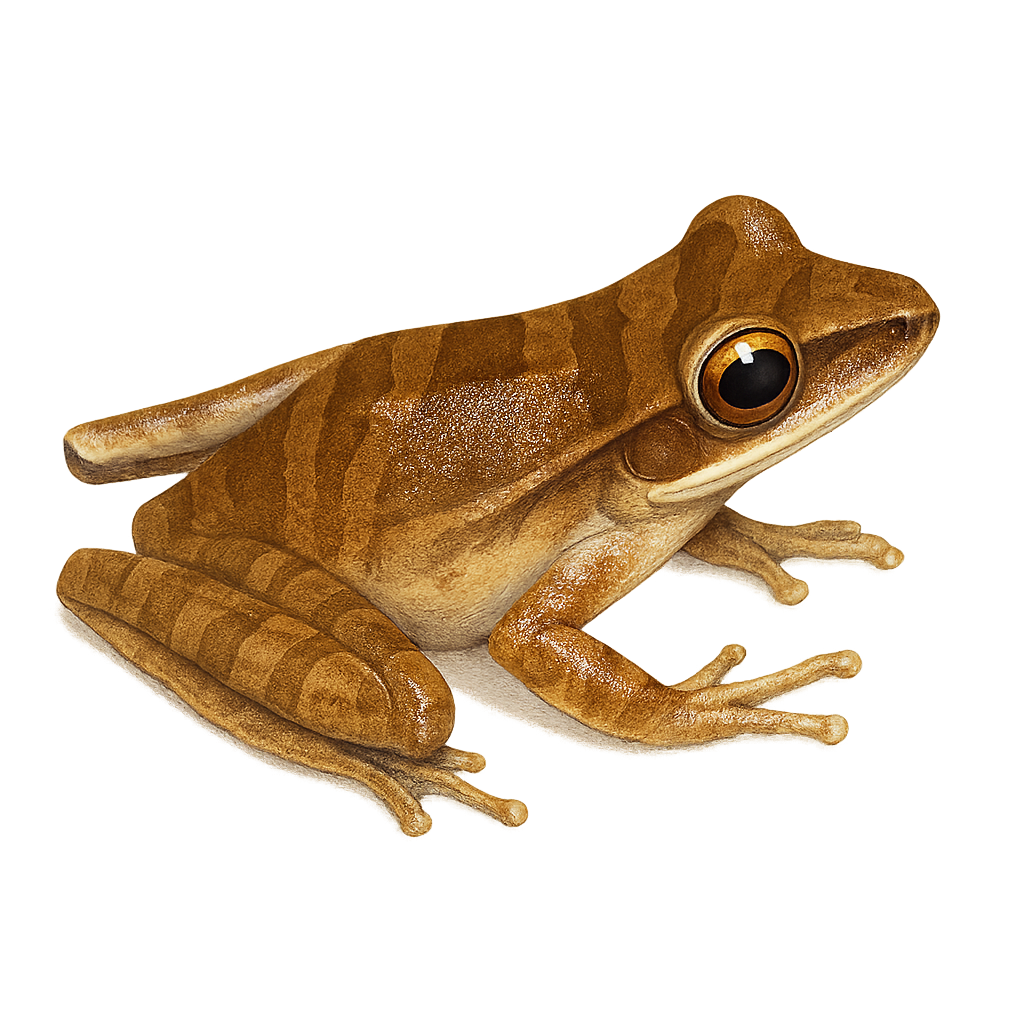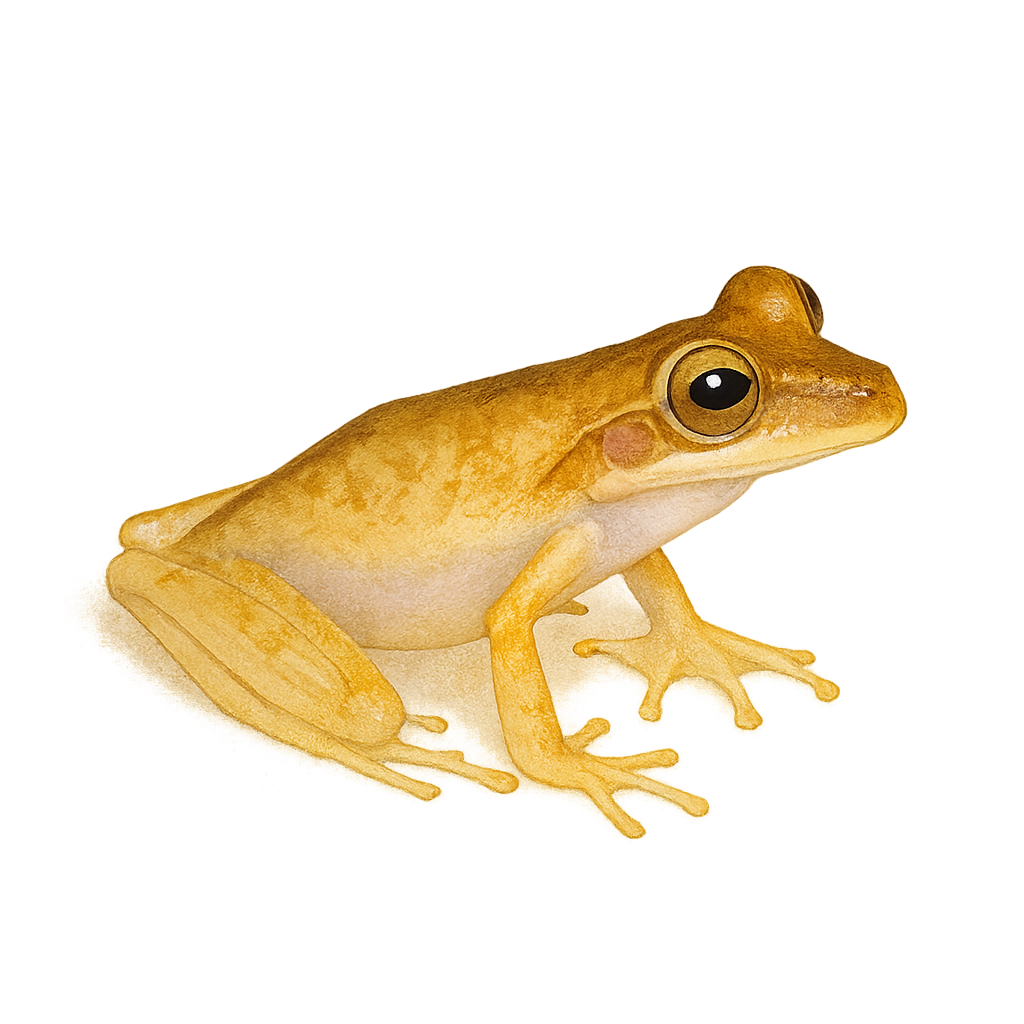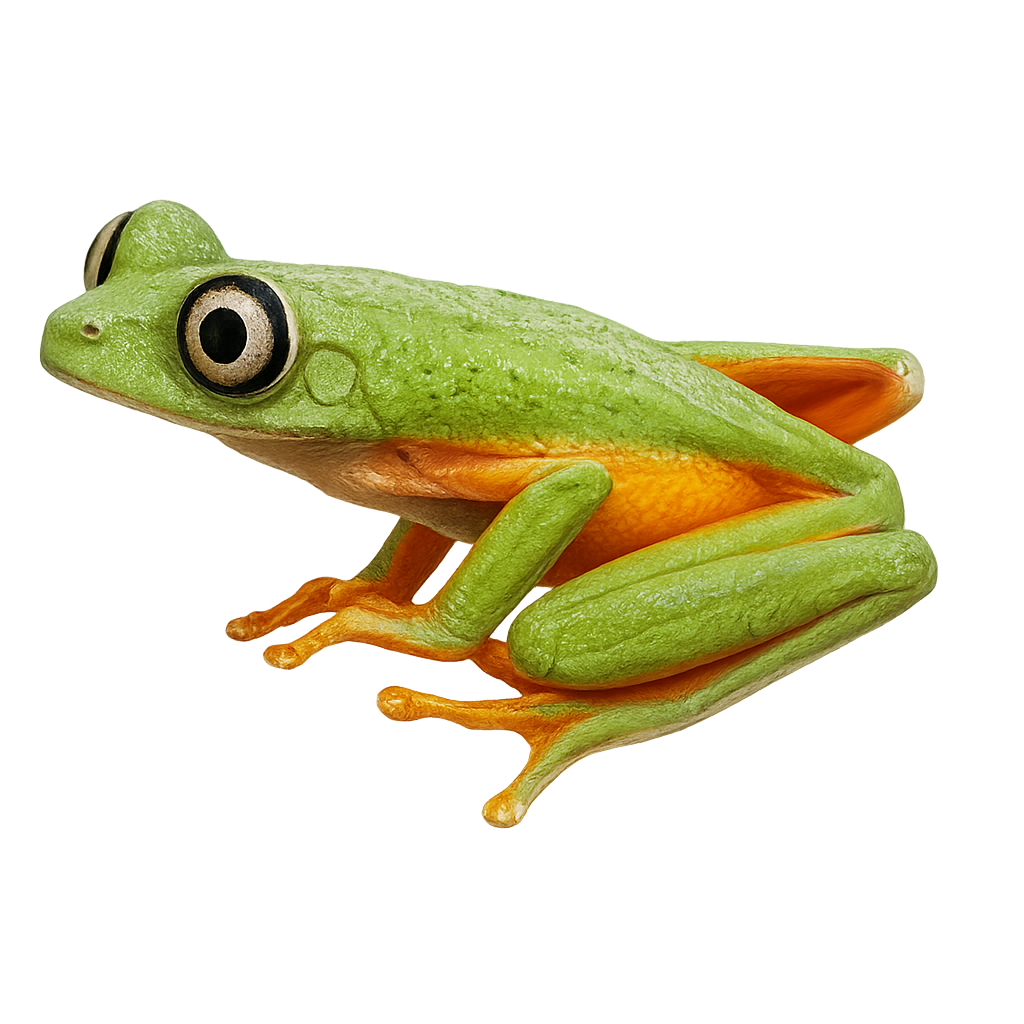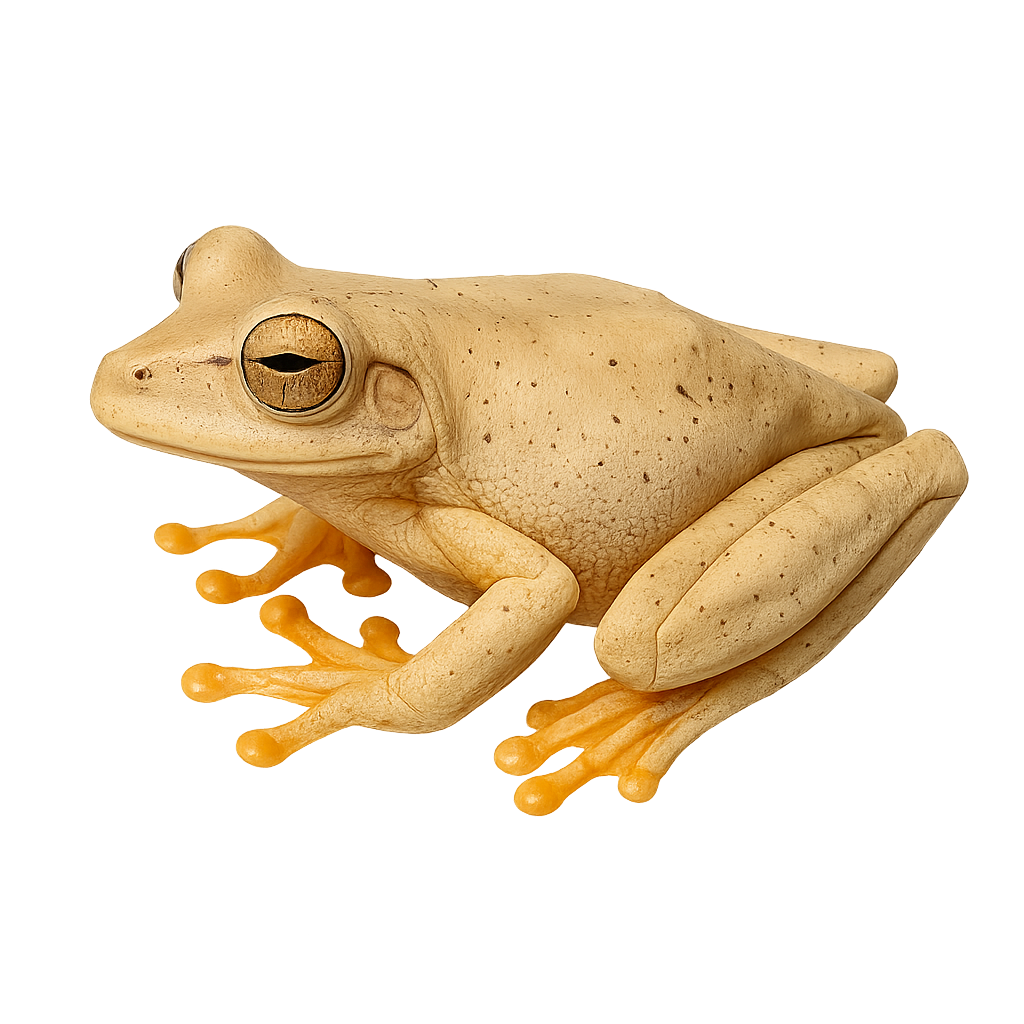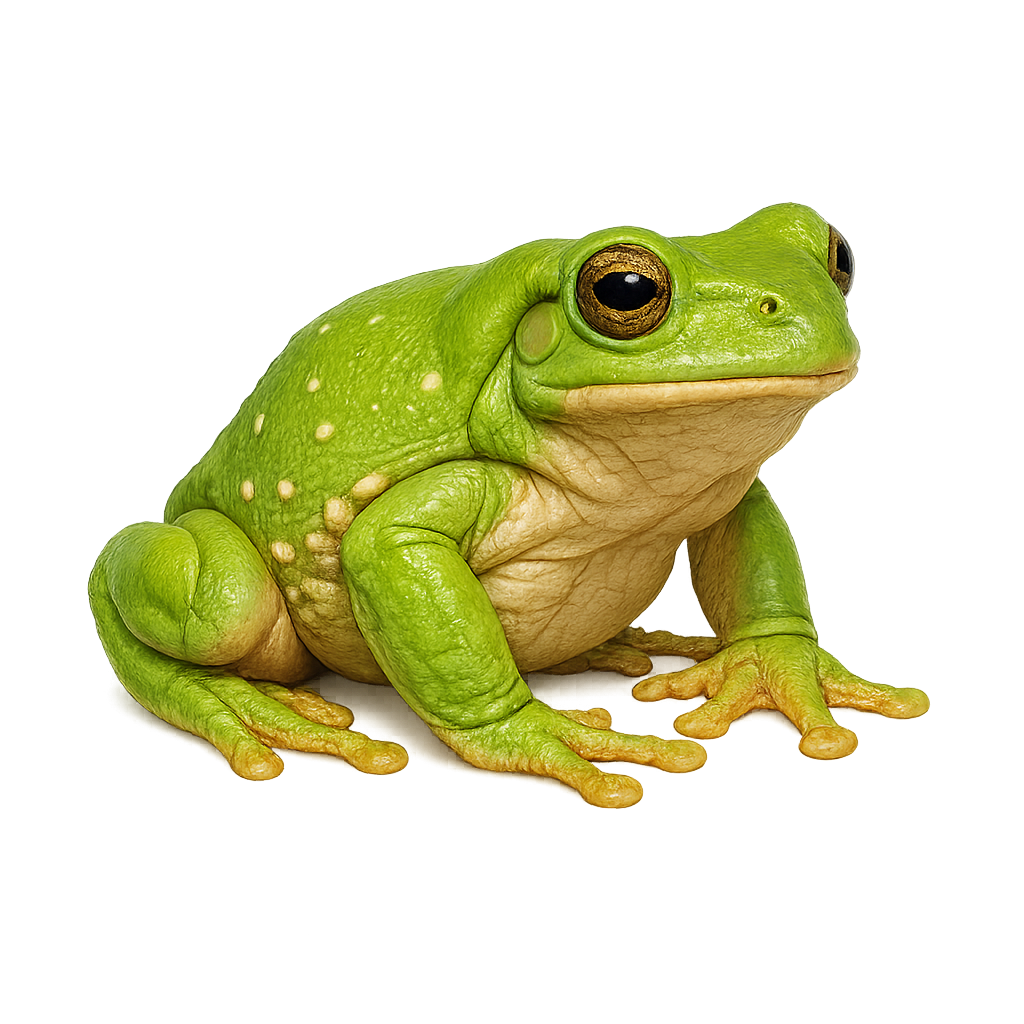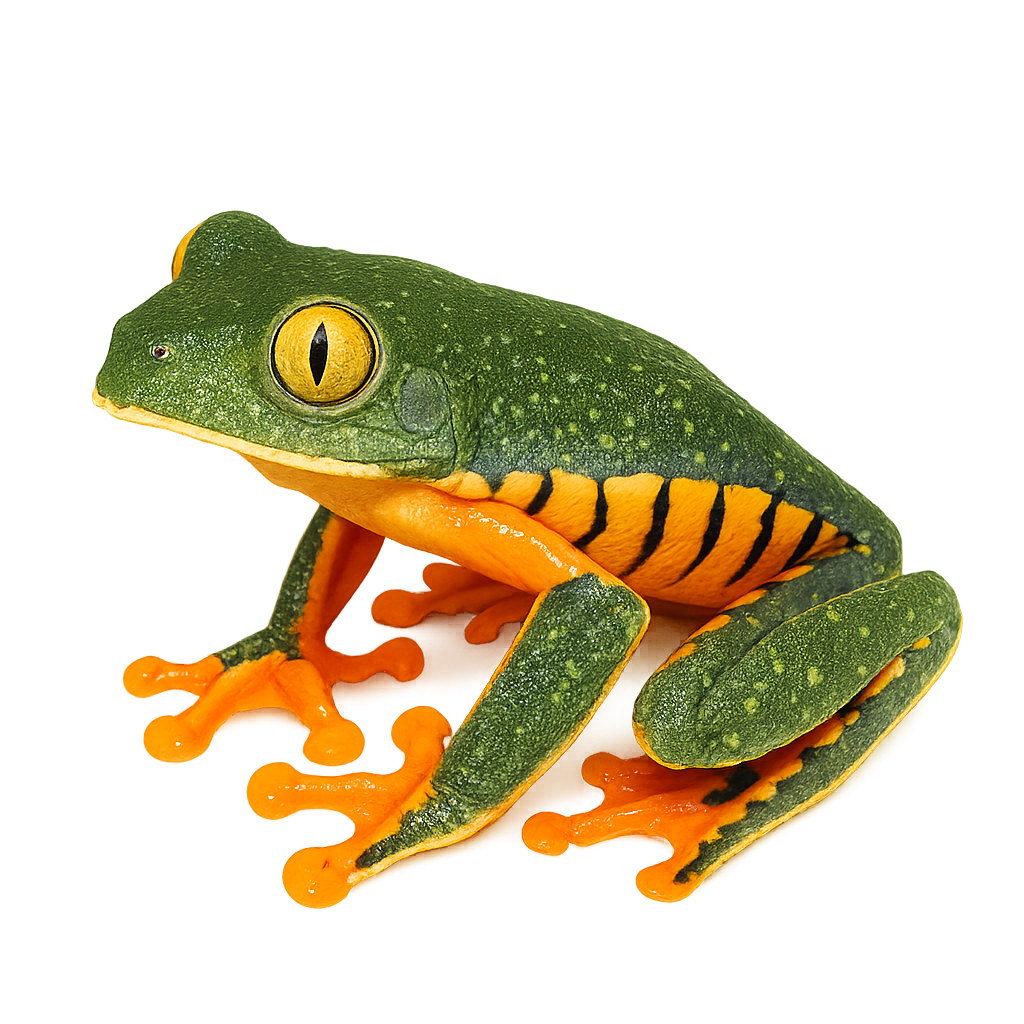The Tiger-striped Leaf Frog, scientifically known as Phyllomedusa tomopterna, is a medium-sized arboreal frog native to the tropical rainforests of South America. It is characterized by its green skin with white spots and prominent eyes. This nocturnal species primarily feeds on insects. Its adhesive toe pads allow it to climb leaves and branches with ease. The Tiger-striped Leaf Frog plays a crucial role in the ecosystem by controlling insect populations. Although it is relatively tolerant of human disturbances, deforestation poses a threat to its natural habitat.
The Black-eyed Monkey Frog is a species of tree frog found primarily in the humid tropical forests of the Amazon. It is recognizable by its smooth, green skin, often speckled with white or yellow spots, which allows it to camouflage effectively among the leaves. This frog is nocturnal and spends the day hidden under leaves or in tree crevices. It feeds mainly on insects and other small invertebrates. The Black-eyed Monkey Frog plays a crucial role in the ecosystem by regulating insect populations. It is also an important indicator of the health of tropical forests, as it is sensitive to environmental changes such as deforestation and pollution.
The Painted-belly Leaf Frog, scientifically known as Phyllomedusa sauvagii, is a remarkable arboreal amphibian native to the dry Gran Chaco region of Argentina, Paraguay, and Bolivia. It is characterized by its thick, waxy skin that helps minimize water loss, an essential adaptation for survival in its arid habitat. Its bright green coloration provides excellent camouflage among leaves, while its golden eyes and adhesive fingers allow it to move effortlessly through trees. This frog is primarily nocturnal, resting during the day to avoid intense heat. It feeds mainly on insects and other small invertebrates. Although its conservation status is currently "least concern," habitat destruction poses a potential threat.
The Brownbelly leaf frog is an arboreal frog native to the tropical forests of South America, mainly in Brazil. It is distinguished by its smooth skin and vibrant colors, often green with distinctive patterns on its legs. This species is known for its nocturnal behavior, hiding in dense vegetation during the day. It plays a crucial role in the ecosystem as a predator of insects. Its ability to secrete chemical substances for defense against predators is fascinating. Although not critically endangered, deforestation threatens its natural habitat, which could affect its population in the long term.
The Orange-legged Leaf Frog is a medium-sized arboreal frog belonging to the Hylidae family. It is recognizable by its smooth skin and bright colors, usually green with white or yellow patterns on the sides. This species is primarily nocturnal and is found in the tropical and subtropical forests of South America, particularly in Brazil, Argentina, and Paraguay. It is well adapted to arboreal life thanks to its adhesive fingers, which allow it to climb easily. The Orange-legged Leaf Frog plays a crucial role in its ecosystem as a predator of insects, thus contributing to the regulation of harmful insect populations.
The Boana semilineata, commonly known as the Semilineated tree frog, is a species of arboreal frog found primarily in the humid tropical forests of South America. It is recognizable by its bright green coloration, often adorned with darker lines or patterns, allowing it to effectively camouflage among the leaves. This species is mainly nocturnal, hiding during the day to avoid predators. It primarily feeds on insects, which it captures with its sticky tongue. The striped tree frog plays an important role in the ecosystem by regulating insect populations. Although its population is stable, it is threatened by deforestation and the loss of its natural habitat.
The Stained Treefrog, commonly known as the spotted tree frog, is a fascinating species from the Hylidae family. It is distinguished by its spotted skin, which allows it to blend effectively into its natural environment. This frog is primarily nocturnal, meaning it is active at night for feeding and breeding. It typically inhabits tropical rainforests, swamps, and riparian zones, where it finds both food and protection. Its ability to blend into the surroundings is impressive, and it uses this skill to evade predators. Although its conservation status is not alarming, it is crucial to protect its habitat to ensure its long-term survival.
The Fringed Tree Frog, or Cruziohyla craspedopus, is a fascinating amphibian species primarily inhabiting the humid tropical forests of South America. It is recognizable by its vibrant coloration, blending shades of green, blue, and yellow, which allows it to effectively camouflage in its natural habitat. This frog also features distinctive fringes along its limbs, from which it derives its name. It is mainly arboreal, spending most of its time in the tree canopy. The Fringed Tree Frog is nocturnal and primarily feeds on insects. It plays a crucial role in the ecosystem by regulating insect populations and serving as prey for many predators. Although its conservation status is concerning, it is still relatively widespread in some areas.
The Blue-sided Treefrog, or Agalychnis annae, is a tree-dwelling frog species native to the humid tropical forests of Costa Rica. It is easily recognizable by its bright red eyes, vivid green body, and blue sides. This frog is primarily nocturnal, resting on leaves during the day. It plays a crucial role in the ecosystem as an insect predator. Unfortunately, it is threatened by deforestation and habitat loss. Conservation efforts are essential to ensure its survival. Its thin, permeable skin makes it sensitive to environmental changes, making it an important indicator of habitat health.
The Red-eyed Tree Frog is a small arboreal frog primarily found in the humid tropical forests of Central and South America, particularly in Costa Rica and Panama. It measures about 5 to 7 cm in length and weighs between 10 and 20 g. Its body is generally green, with yellow or blue spots on the sides, and its eyes are bright red, making it a particularly recognizable species. The Red-eyed Tree Frog is insectivorous, primarily feeding on flying insects like mosquitoes and flies. It is nocturnal and spends the day hidden in foliage or tree crevices. While its population remains stable in certain protected areas, it is still threatened by deforestation and pollution of its natural habitat.
The Demerara Falls Treefrog, or Boana cinerascens, is a species of amphibian in the Hylidae family. It is primarily found in the humid tropical forests of South America, particularly in Brazil, Colombia, and Peru. This frog is characterized by its grayish coloration, which allows it to effectively camouflage in its natural environment. It has suction pads at the tips of its fingers, facilitating its movement in trees. The Ashy Tree Frog is nocturnal and primarily feeds on insects. It plays an important role in the ecosystem by regulating insect populations. Although its conservation status is not of concern, deforestation poses a potential threat to its natural habitat.
The Emerald‑eyed treefrog, scientifically known as Hypsiboas crepitans, is a tree-dwelling frog native to tropical regions of Central and South America. It is characterized by its smooth skin and green coloration, which provides excellent camouflage among leaves. Typically measuring between 3 and 5 cm, this frog has adhesive pads on its toes, aiding in climbing. It is primarily nocturnal, feeding on insects. Its distinctive call, a crepitating sound, is often heard during humid nights, especially in the rainy season.
The Spring Peeper, or Pseudacris crucifer, is a small tree frog native to North America, known for its distinctive call that heralds the arrival of spring. Typically measuring between 2 and 4 cm, it is characterized by a dark X-shaped mark on its back, which gives it its scientific name. It primarily inhabits wetlands, forests, and meadows. Although difficult to spot due to its small size and camouflaging color, its powerful and melodious call is often heard during spring evenings. The Spring Peeper plays a crucial role in the ecosystem by regulating insect populations.
Litoria dayi, commonly known as the Australian Lace-lid, is a tree frog species endemic to Australia. It is characterized by its smooth skin and bright green coloration, often with brown spots. This frog is primarily nocturnal and prefers humid tropical rainforests, where it hides among leaves and branches. Known for its distinctive call, it uses this to attract mates during the breeding season. Although generally discreet, it can be observed near water bodies where it breeds. Unfortunately, Litoria dayi is threatened by habitat loss and diseases, leading to a decline in its population.
The Gliding Tree Frog is a medium-sized nocturnal arboreal frog, measuring between 5 and 8 cm. It has bright green dorsal coloration during the day, turning darker at night, with orange or bluish hues on its flanks and limbs. Its large red eyes and webbed feet enable it to "fly" from tree to tree by gliding. This species inhabits humid tropical forests in Costa Rica, Panama, Colombia, and Ecuador, between 15 and 750 m elevation. It resides in the canopy and descends to the ground to breed in temporary pools formed by rains. Breeding is explosive, with thousands of individuals gathering in a single night to lay eggs on leaves overhanging water. Tadpoles fall into the water upon hatching. Although listed as Least Concern by the IUCN, this species is locally threatened by deforestation and habitat loss.
Cruziohyla sylviae, commonly known as Sylvia's Tree Frog, is a strikingly beautiful species of tree frog native to the humid rainforests of Central America. It is characterized by its vibrant green skin adorned with blue and yellow spots, providing excellent camouflage among the foliage. This nocturnal species spends its days resting on tree leaves and plays a crucial role in the ecosystem by controlling insect populations. Sylvia's Tree Frog is also an important indicator of environmental health, as it is sensitive to habitat changes. Conservation efforts are vital to preserve this species and maintain the ecological balance of tropical forests.
The Litoria caerulea, commonly known as the Australian Green Tree Frog, is a species of arboreal frog native to Australia and New Guinea. It is easily recognizable by its smooth, shiny skin, which is typically emerald green, although some may exhibit bluish hues. This frog is known for its longevity, living up to 16 years in captivity. It has adhesive discs on its fingers, allowing it to climb vertical surfaces with ease. The Australian Green Tree Frog is often found in humid areas, rainforests, and urban gardens. Its docile nature makes it a popular pet.
The Wilcox's Frog, or Litoria wilcoxii, is a tree frog species primarily found in the coastal regions of southeastern Queensland and northeastern New South Wales in Australia. It is recognizable by its smooth skin and bright green coloration, often speckled with golden or brown spots. This frog prefers humid habitats such as rainforests, swamps, and riverbanks with dense vegetation. It is mainly nocturnal, hiding in vegetation during the day and becoming active at night to feed on insects. Although its conservation status is currently "least concern," it is sensitive to environmental changes, particularly habitat loss and pollution.
The Boana pulchella, commonly known as the Elegant Tree Frog, is a species of amphibian in the Hylidae family. It is primarily found in South America, particularly in Argentina, Brazil, and Uruguay. This frog is recognizable by its smooth skin and vibrant colors, usually green with shades of yellow and brown. It measures about 3 to 5 cm in length. The Boana pulchella is an arboreal species that prefers humid habitats, such as tropical and subtropical forests. It is mainly active at night, feeding on insects and other small invertebrates. Although its conservation status is currently "least concern," it is threatened by the loss of its natural habitat due to deforestation and urbanization.
The White-lipped Tree Frog, or Litoria infrafrenata, is a species of tree frog native to Australia and New Guinea. It is the largest tree frog species in the world, reaching up to 14 cm in length. Its coloration ranges from bright green to brown, with a distinctive white stripe along its lower lip. It has adhesive fingers that allow it to easily climb trees. This species is primarily nocturnal and feeds on insects and other small invertebrates. It prefers humid habitats such as rainforests, swamps, and riparian zones. Although it is widely distributed, it is sometimes threatened by habitat loss and pollution.
The Map Treefrog, Boana geographica, is a species of amphibian in the Hylidae family. It is primarily found in the humid tropical forests of South America, particularly in Brazil, Colombia, and Peru. This frog features a green coloration with distinctive geographical patterns on its back, allowing it to effectively camouflage in its natural environment. It is generally nocturnal, feeding on insects and other small invertebrates. The Map Treefrog plays a crucial role in the ecosystem by regulating insect populations. Although its conservation status is currently "Least Concern," deforestation and habitat loss pose potential threats to its long-term survival.
The Dainty Green Tree Frog, Litoria gracilenta, is a species of arboreal frog native to Australia. It is identifiable by its smooth, glossy skin, typically bright green, although some may exhibit shades of yellow or blue. Its eyes are prominent with a horizontal pupil, and its legs are long and slender, adapted for tree-dwelling. It primarily inhabits tropical rainforests, swamps, and wooded areas near water bodies. The Dainty Green Tree Frog is mostly nocturnal, feeding on insects and other small invertebrates. Although widely distributed, it is sensitive to environmental changes, particularly habitat loss and pollution.
The Basin treefrog, or Boana lanciformis, is an amphibian species in the Hylidae family. It is primarily found in the humid tropical forests of South America, particularly in Brazil, Colombia, and Venezuela. Its green and brown coloration allows it to blend effectively among foliage. It has a slender body and long legs, adapted for arboreal life. The Basin treefrog is nocturnal and primarily feeds on insects. It plays a crucial role in the ecosystem by regulating insect populations. Although its habitat is threatened by deforestation, it is currently classified as "least concern" by the IUCN.
The Basin tree frog, scientifically known as Hypsiboas lanciformis, is a species of arboreal frog native to the humid tropical forests of South America. It is characterized by its slender body and long limbs, which allow it to move nimbly among the trees. Its coloration ranges from green to brown, providing excellent camouflage among the foliage. This species is primarily nocturnal, feeding on insects and other small invertebrates. It plays a crucial role in the ecosystem by controlling insect populations. Although its conservation status is currently stable, deforestation poses a potential threat to its natural habitat.
The Lemur Leaf Frog, Agalychnis lemur, is a fascinating species of arboreal frog native to the tropical rainforests of Central America. It is renowned for its striking red eyes and vibrant green skin, which help it blend in with the foliage. At night, it becomes active, hunting insects and other small invertebrates. Its feet are equipped with suction pads that allow it to climb smoothly on slick surfaces. Although primarily nocturnal, it can be seen during the day resting on leaves. This species is an important indicator of forest ecosystem health, as it is sensitive to environmental changes.
The Smith Frog, or Boana faber, is a species of arboreal frog found primarily in the humid tropical forests of South America. It is recognizable by its smooth skin and coloration ranging from brown to olive green, often with darker patterns. This frog is known for its nest-building behavior, from which it derives its name. It uses its hind legs to dig shallow pools in the ground, where it lays its eggs. These pools fill with rainwater, providing a protected environment for the development of tadpoles. The Maçon's Tree Frog is primarily nocturnal, making it difficult to observe during the day. It plays a crucial role in the ecosystem as an insect predator and in the food chain.
The Mexican Giant Tree Frog, or Agalychnis dacnicolor, is a tree-dwelling frog species native to the tropical forests of Mexico. It is easily recognizable by its bright green skin and distinctive red eyes, giving it a striking appearance. This frog is primarily nocturnal, resting on leaves during the day and becoming active at night to hunt insects. It uses its adhesive pads to climb trees and move agilely through its habitat. The Mexican Leaf Frog plays a crucial role in the ecosystem by regulating insect populations and serving as prey for various predators. Although its population is stable, it is threatened by deforestation and habitat loss.
Cruziohyla calcarifer, known as the splendid leaf frog, is a captivating species within the Hylidae family. It is distinguished by its vibrant coloration, featuring an emerald green back speckled with yellow spots and flanks adorned with blue and black patterns. This frog also boasts prominent eyes and webbed feet, adapted to its arboreal lifestyle. It primarily inhabits the humid tropical forests of Central America, where it skillfully camouflages among the leaves. Nocturnal, it feeds on insects and other small invertebrates. Although its habitat is threatened by deforestation, it is currently classified as "Least Concern" by the IUCN.
The Polka-dot Tree Frog, Hypsiboas punctatus, is a species of tree frog found primarily in South America. It is recognizable by its smooth skin and distinctive spotted patterns on a bright green background. These frogs are generally small, measuring about 3 to 4 cm in length. They are nocturnal and spend the day hidden in dense vegetation. Their call is a key part of their reproductive behavior, attracting mates during the rainy season. They primarily feed on insects and play an important role in controlling pest insect populations. Although they are widespread, their habitat is threatened by deforestation and pollution.
The Polka‑dot treefrog, or Boana punctata, is a species of amphibian in the Hylidae family. It is characterized by its smooth skin and dark spots on a bright green background, allowing it to blend effectively into its natural habitat. It is primarily nocturnal and found in the tropical rainforests of Central and South America. It is arboreal, spending most of its time in trees. Reproduction typically occurs during the rainy season, when males call to attract females. Eggs are laid in water, where tadpoles develop before metamorphosing into adult frogs.


